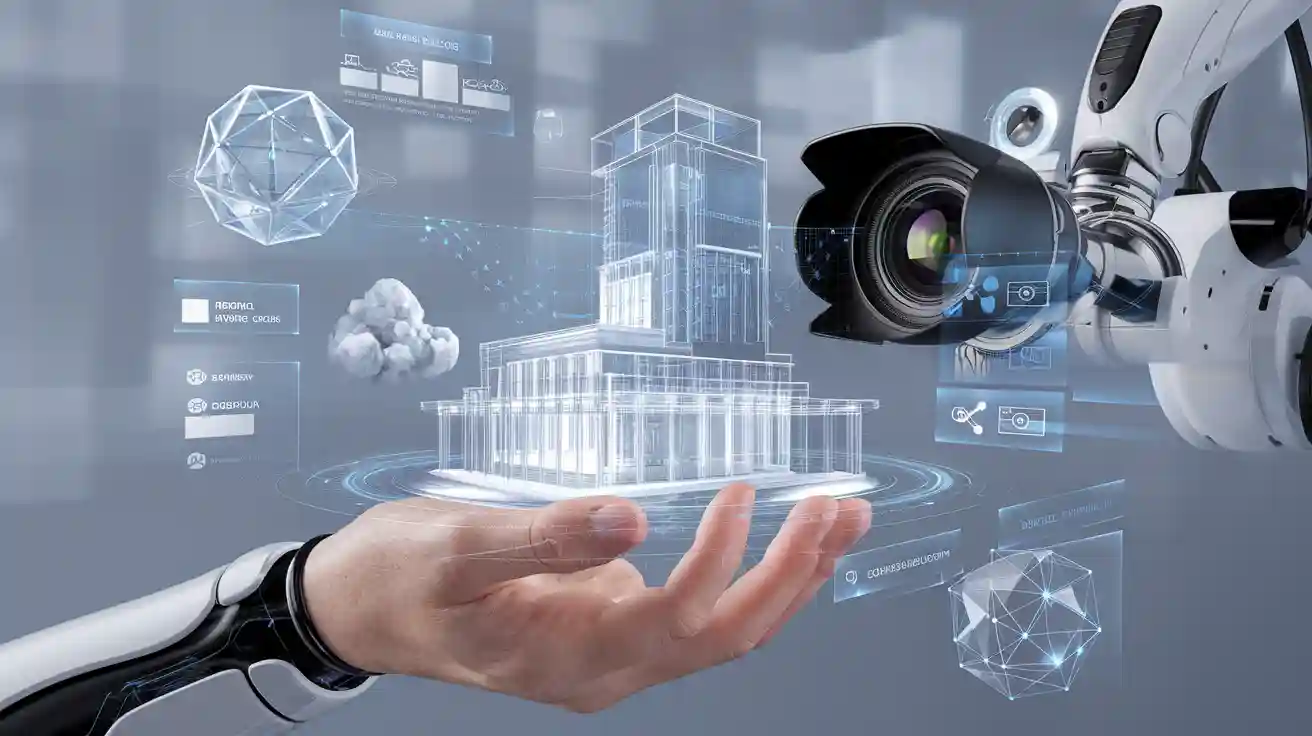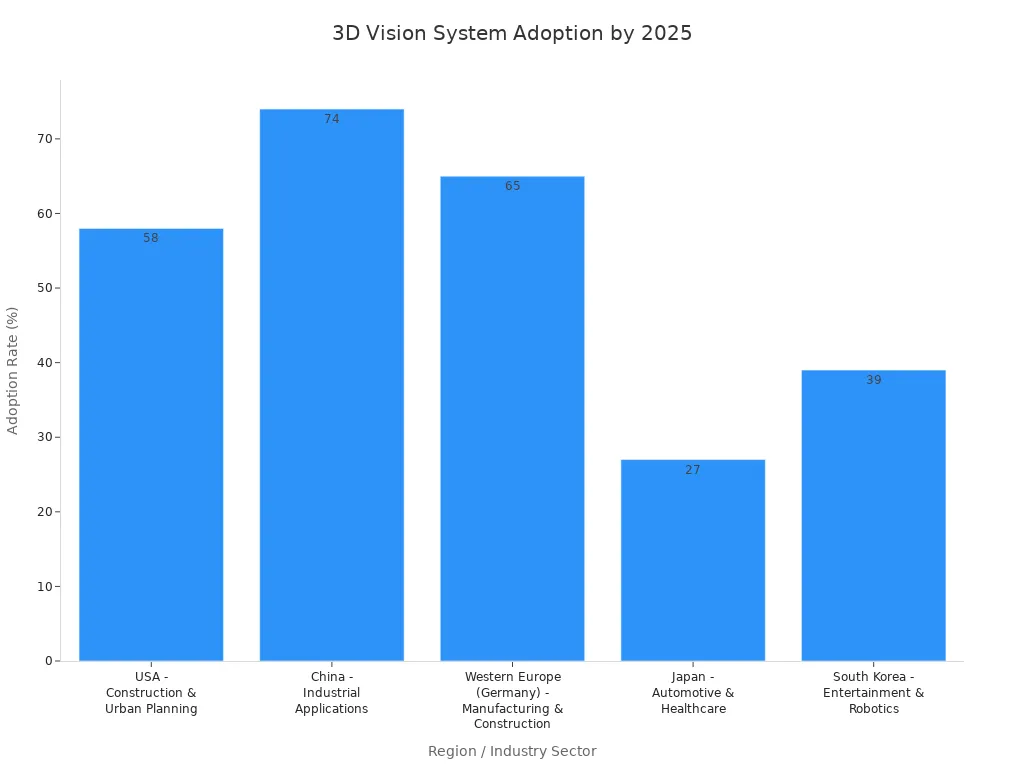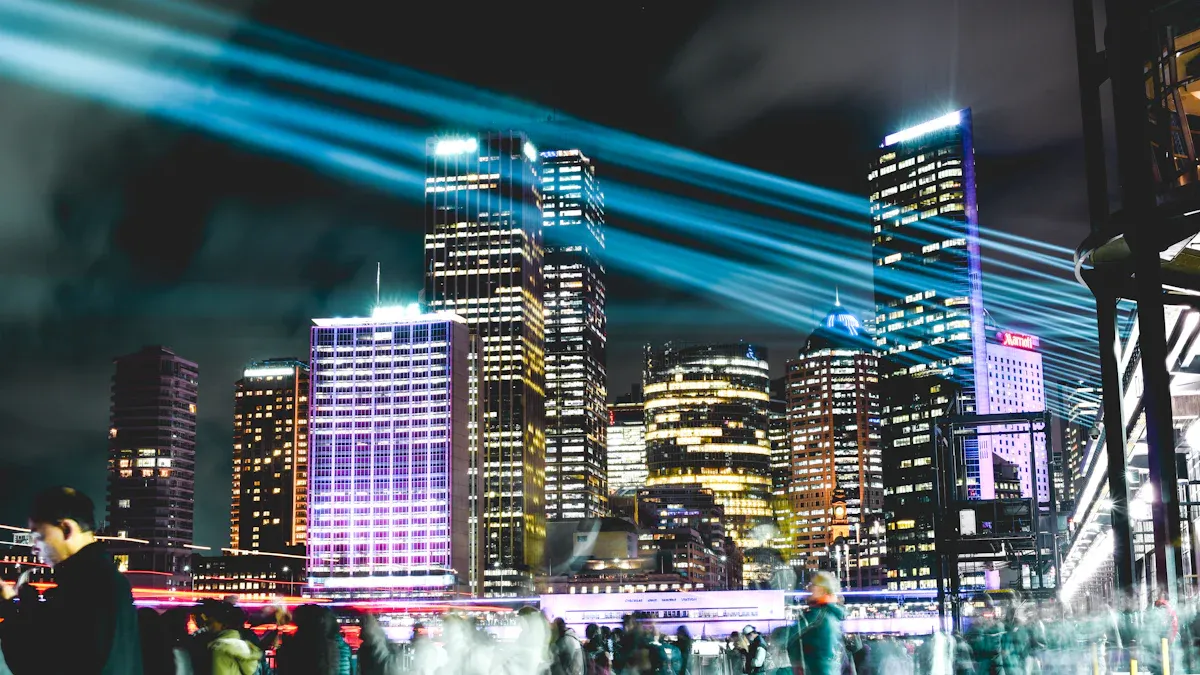
A 3d reconstruction machine vision system in 2025 uses advanced 3d vision to build detailed 3D models from 2D images or sensor data. The core of this 3d vision process lies in combining 3d computer vision, AI, and real-time processing, which drive accuracy and speed. New techniques, such as mmNorm, improve 3d vision systems’ ability to detect hidden objects and complex shapes. The global market for these machine solutions is projected to reach $1,201.3 million in 2025, with broad adoption across manufacturing, construction, and robotics sectors.
| Metric | Value (USD Million) | Year/Period |
|---|---|---|
| Projected Market Size | 1,201.3 | 2025 |
| CAGR (2025-2032) | 8.1% | 2025 to 2032 |

Automation, labor shortages, and government policy support continue to accelerate the adoption of 3d vision and machine vision technology, making 3d vision systems essential for professionals seeking efficiency and innovation.
Key Takeaways
- 3D reconstruction machine vision systems create detailed 3D models from 2D images using advanced cameras, sensors, and AI, improving accuracy and speed.
- These systems help industries like manufacturing, robotics, and healthcare by enabling precise inspection, quality control, and automation.
- Key features include high-precision camera calibration, depth estimation, real-time object tracking, and automated scanning to boost efficiency.
- AI integration enhances the system’s ability to recognize objects, process complex scenes, and adapt to new challenges quickly and accurately.
- Real-time processing and networked multi-camera setups allow fast, large-scale 3D scanning, supporting smarter machines and better decision-making.
What Is It?
Definition
A 3d reconstruction machine vision system uses advanced cameras and sensors to capture images or data from real-world objects. The system then processes this information to create a digital 3D model. Engineers and researchers use these models to study shapes, sizes, and positions with high accuracy. The technology combines computer vision, artificial intelligence, and specialized software to turn flat images into detailed three-dimensional structures. This process helps machines and people see and understand the world in new ways.
Core Purpose
The main goal of a 3d reconstruction machine vision system is to digitally recreate the geometric details of objects or scenes. This digital recreation supports precise modeling, which helps in many fields. For example, factories use these systems to record the exact shape of machine parts, making maintenance easier. Scientists use them to track changes in data over time. The system provides accurate visual information, which improves robot navigation, medical imaging, and even the preservation of historical sites. By turning 2D images or sensor data into 3D information, the system gives machines a better understanding of their surroundings. This improved spatial awareness makes automated systems smarter and more useful in real-world tasks.
Note: The ability to convert simple images into complex 3D models opens new possibilities for design, safety, and automation across industries.
3D Reconstruction Machine Vision System
Key Features
A 3d reconstruction machine vision system in 2025 brings together several advanced features that set it apart from traditional vision solutions. The system uses multiple cameras and sensors to capture detailed information about objects and environments. These machines rely on precise camera calibration to ensure every measurement is accurate. Depth estimation allows the system to understand the position of objects in three dimensions, which is essential for tasks like object recognition and tracking. Feature extraction helps the machine identify unique points or patterns on surfaces, making it easier to match images and build accurate 3D models.
Key features include:
- High-precision camera calibration for reliable measurements.
- Depth estimation to capture the X, Y, and Z positions of objects.
- Feature extraction for identifying and matching key points.
- Real-time object recognition and tracking to follow moving items.
- Robust image matching for combining data from different views.
- Automated scanning processes that reduce manual labor.
- Advanced 3d computer vision algorithms for complex scene analysis.
These features work together to deliver high accuracy and efficiency, making 3d vision systems essential in industries that demand strict quality control and automation.
Technologies
The core technologies behind a 3d reconstruction machine vision system include a combination of hardware and software components. Cameras and sensors form the foundation, capturing images and depth data from the environment. The system uses camera calibration to align and synchronize multiple viewpoints, which is critical for accurate 3d computer vision. Feature extraction algorithms identify unique patterns or points in each image, while image matching techniques combine these features across different views.
The process often involves several steps:
- Data Capture: Cameras and sensors collect 2D images and depth information.
- Camera Calibration: The system aligns all cameras to ensure measurements are consistent.
- Feature Extraction: Algorithms find key points in each image.
- Image Matching: The machine matches features between images to reconstruct the scene.
- Depth Estimation: The system calculates the distance of each point from the cameras.
- 3d Computer Vision Processing: Advanced software builds a 3D model from the matched features and depth data.
Note: 3d vision systems use scanning and depth estimation to create detailed models that support tasks like robotic guidance, inspection, and automated sorting.
A comparison between 3d vision systems and traditional 2D vision systems highlights the advantages of 3d computer vision:
| Aspect | 3D Vision Systems | 2D Vision Systems |
|---|---|---|
| Accuracy | Captures depth (X, Y, Z axes) enabling precise measurement of height, width, and depth. Ideal for volumetric inspection, shape analysis, and complex geometries. | Limited to X and Y axes; cannot perceive depth, restricting accuracy in 3D measurements and complex shapes. |
| Efficiency | Enhances robotic guidance (e.g., bin-picking) with spatial awareness, improving speed and precision in unstructured environments. Less sensitive to lighting variations, increasing robustness. | Simpler and faster to implement; excels in high-speed surface inspections, barcode reading, and presence/absence detection in controlled environments. Sensitive to lighting changes. |
| Application Suitability | Best for industries requiring strict quality control (aerospace, automotive), complex object handling, and dynamic environments. | Best for simpler, high-throughput tasks with controlled lighting, such as surface defect detection and code reading. |
| Implementation Complexity | More complex and costly due to advanced hardware and software requirements. | Simpler, more cost-effective, and easier to deploy. |
3d vision systems provide unmatched accuracy and flexibility, making them the preferred choice for industries that need detailed inspection and automation.
AI Integration
AI integration has transformed the capabilities of the 3d reconstruction machine vision system. Machine learning and deep learning algorithms now play a central role in improving accuracy and automation. These AI-driven systems use advanced image processing to enhance feature extraction, depth estimation, and object recognition and tracking. The machine can now interpret complex scenes with greater precision, even in challenging environments.
For example, in agriculture, AI-powered 3d vision systems enable machines to detect and localize fruits or crops with high accuracy. The system captures position, orientation, and 3D point clouds, then uses AI to process this data quickly. This approach leads to faster and more reliable detection, which boosts operational speed and reduces errors. AI also helps automate scanning and analysis, allowing machines to handle more tasks without human intervention.
AI-driven 3d computer vision not only increases accuracy but also makes the system more adaptable to new challenges. As a result, industries benefit from smarter machines that can learn and improve over time.
3D Scanning and Processes
3d scanning in 2025 follows a clear sequence of steps to create accurate 3D models. The process starts with capturing data, then moves to generating a point cloud, followed by meshing and texturing, and ends with analysis. Each step uses advanced tools and methods to ensure high quality and reliability.
Data Acquisition
3d scanning begins with data acquisition. Sensors and cameras measure and record the physical properties of objects. In 2025, 360-degree photogrammetry stands out as a leading method. For example, the BaliMask3D dataset used Polycam to capture over 100 high-resolution images of each mask. This approach preserved fine details and supported advanced 3d scanning workflows. Preprocessing steps, such as noise removal and mesh refinement, prepare the data for machine learning and further processing. Structure from motion and depth estimation play key roles in this stage, helping align images and extract 3D information.
Point Cloud Generation
After data acquisition, the system generates a point cloud. This step uses technologies like LiDAR, stereo cameras, and multispectral imaging. These sensors collect data from different angles and viewpoints. Computer vision and deep learning methods, such as structure from motion and coarse-to-fine networks, process the images to build a detailed point cloud. Structure from motion helps match features across images, while depth estimation adds the third dimension. The point cloud forms the foundation for further 3d scanning steps.
- Leading techniques for point cloud generation:
- LiDAR and laser scanners
- Stereo cameras
- Multispectral imaging
- Deep learning networks for multi-view reconstruction
Meshing and Texturing
Meshing and texturing transform the point cloud into a usable 3D model. The MeshFormer model, for example, uses signed distance functions and surface rendering to create high-quality meshes quickly. Texturing adds color and surface detail, using both RGB and normal textures. These processes rely on image matching and structure from motion to ensure geometric accuracy. The result is a textured mesh with high fidelity, which is essential for inspection and other applications that demand quality.
Analysis
The final step in 3d scanning is analysis. Experts validate the accuracy of the reconstructed models using geometric analysis and morphometric techniques. They measure surface distances and compare the model to gold-standard references. Methods like centroid size, Procrustes distances, and principal component analysis help assess shape and quality. This comprehensive approach ensures that the 3d scanning process delivers reliable results for tasks such as inspection, automation, and research.
3d scanning in 2025 combines advanced data acquisition, point cloud generation, meshing, and analysis to deliver precise and high-quality 3D models for a wide range of industries.
Applications in 2025

Manufacturing
Manufacturing in 2025 relies on 3d scanning and machine vision systems to improve every step of the production process. These systems use advanced 3d scanning to create digital replicas of parts and products. Factories use machine vision for inspection and quality control. The technology checks for defects, measures dimensions, and ensures each product meets strict quality standards. Automated inspection reduces waste and improves material use. Machines can now perform real-time error detection, which helps prevent downtime and keeps production lines moving. High-speed 3d scanning tools like MotionCam-3D allow for dynamic scene analysis and complex object handling. This leads to better resource optimization and safer work environments. The quality inspection process becomes faster and more reliable, supporting Industry 4.0 goals.
- Common uses in manufacturing:
- Inspection of automotive, electronics, and aerospace parts
- Assembly verification and defect detection
- Advanced driver assistance systems
- Food safety and packaging inspection
- Inventory tracking and package sorting
Robotics
Robotics benefits from 3d scanning and machine vision by gaining better object recognition and tracking abilities. Robots use 3d scanning to understand their surroundings and interact with objects more precisely. Machine vision systems provide depth data, which helps robots pick, place, and move items safely. These systems enable robots to adapt to new tasks and environments. Companies use 3d scanning to improve robotic guidance, making robots more flexible and efficient. Machine vision also supports safer human-robot collaboration by allowing robots to detect obstacles and avoid accidents. The result is higher quality and productivity in industrial settings.
Medical Imaging
Medical imaging has changed with the use of 3d scanning and machine vision. Hospitals use these systems to turn CT and MRI scans into detailed 3D models of organs and tissues. Surgeons use these models to plan and perform complex procedures with greater accuracy. Machine vision helps segment anatomical structures, improving diagnosis and treatment planning. Real-time AI guidance during surgery increases precision and reduces risks. 3d scanning also supports the creation of patient-specific surgical guides using 3D printing. These advances lead to better patient outcomes and higher quality care.
Automation
Automation across industries now depends on 3d scanning and machine vision for inspection, quality control, and process optimization. Machines equipped with 3d scanning can perform real-time inspection, reducing the need for human intervention. The table below compares 3d scanning systems with traditional 2D camera setups in automation:
| Feature | 3D Scanning Systems | 2D Camera Setups |
|---|---|---|
| Depth Data | Direct and immediate | Requires complex algorithms |
| AI Integration | Simple and efficient | More complex |
| Precision | High for object handling | Lower for 3D tasks |
| Hardware Cost | Higher | Lower |
| Flexibility | Limited field of view | More scalable |
Companies like Smart Robots and Bear Robotics use 3d scanning and machine vision to improve error detection, navigation, and operational efficiency. These systems help machines perform complex tasks, increase safety, and boost productivity. Automation powered by 3d scanning leads to better quality, faster workflows, and smarter decision-making.
Trends for 2025
Real-Time Processing
In 2025, real-time processing stands as a defining trend in 3d vision. Machine vision systems now deliver instant feedback during scanning, supporting applications like robotic guidance and surgical navigation. High-speed GigE Vision cameras capture images at 60 frames per second with zero data loss. Multi-server setups handle up to 600Gbps, ensuring no interruption during scanning. Synchronization through IEEE 1588 PTP v2 achieves sub-microsecond timing, which boosts accuracy for every scan. GPUDirect technology transfers images directly to the GPU, reducing latency and supporting deep learning tasks. The eCapture Pro software enables plug-ins for pattern matching and deep learning inference. These advances allow a machine to reconstruct a full-color 3D model in as little as 30 seconds, making real-time scanning practical for industries that demand high accuracy.
| Technology Component | Description |
|---|---|
| GigE Vision Cameras | 25MP, 60fps, zero-copy image transfer, zero-data-loss |
| Data Throughput | Multi-server, 600Gbps, zero data loss |
| Synchronization | IEEE 1588 PTP v2, sub-microsecond accuracy |
| GPU Integration | GPUDirect, direct image transfer to GPU |
| Software Plug-ins | Deep learning, pattern matching, SSD recording |
| Multi-camera Scalability | Up to 48 cameras, GPU handles compute tasks |
Networked Systems
Networked systems have become essential for modern 3d vision. Machines now connect dozens of cameras and sensors, all working together for large-scale scanning. These systems use advanced networking to share data instantly, which improves accuracy and speeds up scanning. Multi-camera setups allow a machine to scan complex environments from many angles. This approach supports industries like manufacturing and healthcare, where high accuracy and fast scanning are critical. Networked systems also help with remote monitoring and cloud-based analysis, making 3d computer vision more accessible.
- Machines can scale to dozens of cameras.
- Synchronization ensures every scan matches perfectly.
- Networked systems support cloud-based 3d computer vision analysis.
AI-Driven Advances
AI-driven advances continue to shape 3d vision in 2025. Machine learning and deep learning models now handle complex scanning tasks with greater accuracy. These models help a machine recognize objects, adapt to changing environments, and reduce errors during scanning. AI improves feature extraction and pattern matching, which leads to better 3d computer vision results. However, organizations face challenges such as hardware limitations, power consumption, and the need for multidisciplinary expertise. High costs and integration complexity also remain barriers. Despite these challenges, AI-driven 3d vision systems deliver smarter scanning, higher accuracy, and more reliable automation across industries.
AI-powered 3d vision makes scanning faster, more accurate, and more adaptable, helping industries meet new demands in 2025.
3D reconstruction machine vision systems in 2025 transform inspection and quality processes across industries. These systems deliver precise inspection, ensuring high quality and reliable quality control. Companies achieve better inspection results with advanced quality control, supporting consistent quality in every product. New technologies, such as GANs and Vision Transformers, enhance inspection accuracy and quality. Real-time inspection and edge AI improve quality control and speed. Robotic guidance and time-of-flight sensors enable rapid inspection and maintain quality. Professionals rely on these systems for inspection, quality, and quality control, driving industry-wide improvements in inspection and quality.
FAQ
What industries use 3D reconstruction machine vision systems in 2025?
Manufacturing, robotics, healthcare, and construction all use these systems. Companies in these fields rely on 3D vision for inspection, automation, and quality control. These systems help improve accuracy and efficiency in daily operations.
How does AI improve 3D reconstruction accuracy?
AI analyzes images and sensor data to find patterns and features. Deep learning models help the system recognize objects and correct errors. This process leads to more precise 3D models and faster results.
Can 3D vision systems work in real time?
Yes. Modern systems process data instantly. High-speed cameras and advanced software allow machines to scan and analyze objects without delay. Real-time feedback supports tasks like robotic guidance and medical imaging.
What hardware do these systems require?
A typical setup includes multiple cameras, depth sensors, and a powerful computer. Some systems use LiDAR or multispectral sensors. The hardware must support fast data capture and processing for accurate 3D modeling.
Are 3D reconstruction systems easy to integrate?
Most modern systems offer plug-and-play features. Many provide user-friendly software and support for networked devices. Integration may still require technical expertise, but companies design these systems for easier deployment in industrial environments.
See Also
A Comprehensive Look At Robotic Vision Systems In 2025
Advancements In Machine Vision Segmentation Technologies For 2025
Analyzing Field Of View Importance In Vision Systems 2025
The Impact Of 3D Scanning Technology On Machine Vision
Understanding Computer Vision Models Within Machine Vision Systems








